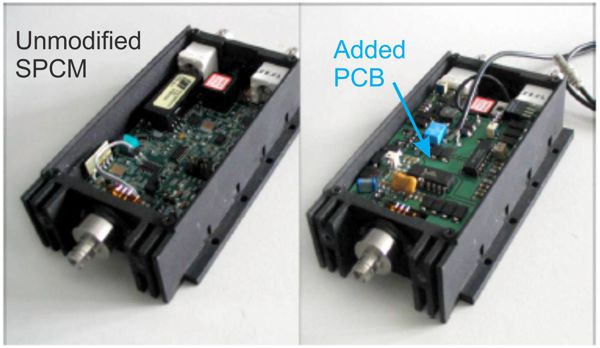 I. Rech, I. Labanca, M. Ghioni, and S. Cova of the Politecnico di Milano in Italy described an interesting modification to the Perkin Elmer SPCM-AQR Single-Photon Counting Module (SPCM) to improve its timing characteristics in:
I. Rech, I. Labanca, M. Ghioni, and S. Cova of the Politecnico di Milano in Italy described an interesting modification to the Perkin Elmer SPCM-AQR Single-Photon Counting Module (SPCM) to improve its timing characteristics in:
I. Rech, I. Labanca, M. Ghioni, and S. Cova, “Modified single photon counting modules for optimal timing performance“, Rev. Sci. Instrum. 77, 033104 (2006); doi:10.1063/1.2183299 (5 pages).
At an incident count rate of 2 Mcounts/s the modified module gives FWHM 200 ps, to be compared with FWHM 430 ps of the original module at the same counting rate. At 3 Mcounts/s, the shift of the peak for the modified module is less than 40 ps, to be compared with a shift of more than 700 ps observed for the original module.
The abstract reads:
“A modification of a standard Perkin Elmer SPCM-AQR photon detector module that remarkably improves the photon timing performance is presented here. The modification consists of an additional timing circuit board, which is inserted in the module without modifying the original circuit board. The essential feature is a pulse pickup linear network, connected to the high-voltage terminal of the photodetector, which extracts a short pulse signal with fast rise, coincident with the rise of the avalanche current. The information about the photon arrival time is obtained by sensing the onset of the rise. At low counting rates (<105 counts/s) time-correlated photon counting tests show that the instrumental resolution function (IRF) thus obtained has full width at half maximum (FWHM) narrower by about 40% with respect to the original module. At higher counting rate, up to few Mcounts/s, the advantage is even more remarkable: The timing circuit practically eliminates the drawbacks that plague the original module, namely, a progressive increase of the FWHM and a progressive shift of the peak position of the IRF with increasing counting rate. The modified SPCM-AQR module is therefore suitable also for applications requiring subnanosecond time resolution at high and/or variable counting rate, such as fluorescent decay measurements, fluorescent lifetime imaging, single molecule detection and spectroscopy, and optical radar techniques.”
Low-res copy of paper: SPCM Timing Mod
